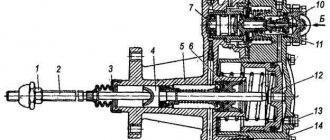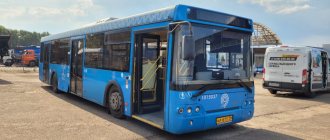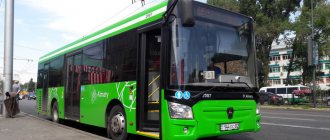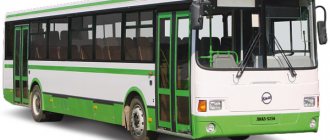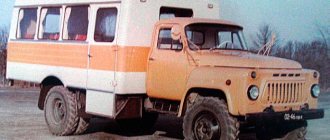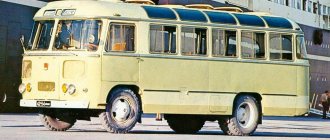LiAZ-5256 in two- and three-door versions
The LiAZ-5256 bus has several main modifications:
- for urban transportation;
- suburban or intercity option;
- for transporting children;
- special variety for disabled people.
This bus also has its downsides. These include high fuel consumption and insufficient durability of new engine models that entered service after 2007. However, vehicle repairs are inexpensive, and all the necessary parts are freely available.
Cosmopolitan bus
In the early 1970s, the development of a unified design of a passenger bus was launched, which was supposed to be supplied to the countries of the European socialist camp within the framework of CMEA cooperation. From the Soviet side, the Head Union Design Bureau for Buses (Lvov) participated in this work, and from the Hungarian side, the Ikarus plant and the Autokut Institute. The choice of project participants is quite understandable: on the one hand, this is the main Soviet organization for the development of buses, on the other, the largest bus manufacturer in Europe at that time.
The first version of the bus, which received the proper name “Mir” and the index 11-630, was manufactured in 1974. After its testing and a number of necessary bureaucratic approvals, in 1977 the USSR approved the technical specifications and determined the manufacturing plant for the future unified model. It became the Likinsky Bus Plant, which at that time produced buses of the LiAZ-677 family. The new model of the bus, according to the industry standard in force in the USSR, received the index LiAZ-5256, and its Hungarian counterpart - Ikarus 415. By 1981, the layout of the new car in its current form had practically taken shape, and the exterior of the prototypes was already indistinguishable from the buses that went into production. Before the start of serial production of LiAZ-5256, 15 buses were assembled in Lvov as part of development work.
LiAZ-5256 - dimensions
- length - 11400 mm;
- width - 2500 mm;
- height - 3007 mm.
Most of the parts are made on machines using plasma cutting or lasers. The side panels undergo a cataphoresis procedure, which reliably protects them from corrosion. The LiAZ-5256 bus is painted manually due to its large dimensions.
My Dagestan
The most beautiful bus in my opinion.
The design of domestic three-door city buses with increased capacity began in the mid-60s.
The result was the LAZ-696 .
And also the world's first low-floor bus - LAZ-360EM (1970). But both promising projects did not go further than prototypes.
Then the State Planning Committee decided that the purchase of Hungarian Ikarus would be more effective than the development of its own original models. At the end of the 70s, the need to create our own new bus with increased capacity became obvious.
Domestic buses LAZ-695 and LiAZ-677 were hopelessly outdated and had many significant shortcomings, and there were not enough Hungarian Ikaruses for the entire vast country. Therefore, the designers resumed work on a three-door city bus. This is how the 11-630 Mir bus appeared.
11-630 "World" (experimental, 1974). Produced in a single copy.
The large city bus 11-630 "Mir" was manufactured by the Lvov GSKB for buses according to the joint work plan of Hungary and the USSR. It belonged to a promising family of city buses, the release of which was scheduled for 1985.
The bus was equipped with a YaMZ-740 engine, developed for the KamAZ-5320 truck, as well as an original automatic transmission and drive axle developed at GSKB. A feature of the transmission of the Mir bus was the misalignment of the input and output shafts of the gearbox and the use of a portal axle with final drives and a main gear shifted to the left side. This solution made it possible to lower the floor level to 630 mm and increase the interior height of the cabin to 2100 mm.
What stood out especially clearly was a solution that was uncharacteristic even for the global bus industry—retractable footrests for passenger doors. The suspension of all wheels is pneumatic.
LiAZ-5256 (experimental No. 102-E 1979).
In the second half of the 1970s, the project to unify city buses, jointly created by specialists from the VKEI bus industry, NAMI from the Soviet side and the Autokut design institute, the Csepel and Ikarus plants from the Hungarian People's Republic, received further development.
In January 1977, the Ministry of Automotive Industry approved the technical specifications for a family of buses to be developed at automobile factories of the USSR, and in 1978, VKEI busprom, based on the results of testing the 11-630 Mir bus, prepared a technical design for a model 5256 bus of a similar design.
The first 2 cars (No. 102-E and No. 103-E) were assembled in the experimental workshop of VKEIavtobusprom in 1979. The first sample (No. 102-E) had the same layout as the experimental bus 11-630 "Mir": the KamAZ-740 engine was located in the rear overhang of the body on the left side, and the drive axle had a portal beam and a main gear shifted to the left. A radiator from KamAZ-5320 was installed in the cooling system.
LiAZ-5256 (experimental No. 103-E 1979).
Simultaneously with the prototype with index No. 102-E, another prototype with index No. 103-E was built with a standard Raba drive axle. This was done due to the expected delay in the development of portal drive axles with offset main gears. Its use required redevelopment of the vehicle: the KamAZ-740 engine was installed in the rear overhang, and the radiator was installed in the left side of the engine compartment (as on LAZ buses). At the same time, the floor level in the front and middle parts was 645 mm, and then increased to 954 mm on the rear platform. Installing passenger seats along the rear wall of the body on the engine casing while maintaining dimensions required narrowing the rear doorway.
During tests No. 102-E and No. 103-E, a significant number of shortcomings were revealed, the main one being problems with the reliability of the air suspension.
In 1982, these buses were tested in Moscow and, based on their results, were sent for revision.
In 1985, a batch of experimental vehicles was produced at the Likinsky plant.
How did it happen that a bus designed in Lvov began to be produced at the Likinsky plant near Moscow? The fact is that back in 1966, on the basis of the LAZ design bureau, the Head Union Design Bureau for Buses (GSKB) was organized, later transformed into the All-Union Design and Experimental Institute (VKEI) of bus construction. This organization, together with the Scientific Automotive Institute (NAMI), was called upon to determine technical strategies in the field of bus manufacturing for the entire USSR. In the 70s and 80s, GSKB, which had enormous scientific and technical potential, designed buses that were produced not only in Lviv, but also at other bus factories in the country.
The new bus LiAZ-5256 was designed to replace the previous generation model - LiAZ-677. He was very different from his predecessor. It received a much more spacious interior (the number of seats was increased to 120), a modern design body, and three full-size planetary-type double doors.
The layout of the bus itself has changed - the engine is located in the rear overhang, which makes it possible to increase the usable area of the cabin, facilitate access to the engine and improve the working conditions of the driver.
The bus was equipped with a diesel 8-cylinder V-shaped engine of the YaMZ-740 model and a three-speed hydromechanical gearbox. The height of the cabin floor was 740 mm, which was the best indicator in its class of buses. The interior ventilation was natural, due to three hatches located in the roof and side window vents. The LiAZ-5256 bus interior was heated by four, and the driver's workplace by two radiator-type heaters, powered by an independent liquid heater.
In 1988, LiAZ-5256 began to be produced in small batches; at that time, buses were delivered mainly to Moscow.
The start of mass production of the model occurred in 1989; the bus was produced for a long time in parallel with the LiAZ-677, and bus fleets were reluctant to take on the new unreliable car.
The automatic hydromechanical transmission was controlled using the “1 2 3 NR” keys located on the dashboard.
But due to difficulties in mastering the new Lvov-made automatic transmission, the bus began to be equipped with a KamAZ-141 manual gearbox, which was not very suitable for intensive work on city routes.
A suburban modification of the bus also began to be produced, which received the index LiAZ-52565 .
The commuter bus differed from the city bus in the absence of a middle door and a four-row interior layout.
From 1991 to 1995, the performance of the Likinsky plant deteriorated significantly, which led to an economic crisis and a shutdown of production in 1996. The situation was complicated by a fire at the YaMZ-740 engine plant. A bankruptcy case was initiated and in 1997 external administration was introduced, then bankruptcy proceedings.
However, the territory, property of the bus plant, and its production activities were preserved. This made it possible to resume bus production in 1998, creating a whole line of city, suburban and intercity buses based on the base model LiAZ-5256.
Since 1998, buses began to be equipped with manual transmissions of both domestic and imported origin - KamAZ-141, ZF S6-85, Voith D851.2.
The LiAZ-5256.25 model with a Caterpillar CAT-3116 engine was developed especially for Moscow .
Since 2000, LiAZ has been consistently implementing a technical re-equipment program. Many defects were eliminated, which made Likino buses one of the most reliable vehicles produced in the CIS.
The bus body undergoes the so-called cataphoresis treatment, consisting of 8 cataphoresis priming baths, 12 painting and 10 drying chambers.
Buses also began to be produced with seamless sides, wheel arches made of galvanized steel, and welding of the body base is carried out using Swedish robots. All these measures made it possible to extend the warranty period of the body to 12 years.
As a result, LiAZ-5256, even despite the emergence of numerous competitors (Volzhanin, NefAZ, RoAZ, MARZ), has become the most popular and in demand large-class city bus on the market.
Since 2001, buses began to be equipped with the Yaroslavl YaMZ-236 engine, which is much more reliable than the YaMZ-740 engine.
Changes also affected the interior of the bus - the quality of finishing materials has improved, separate seats, belts on the handrails, and a fenced middle platform have appeared.
Since 2004, the plant has been producing buses with a modified front and rear design due to the installation of plastic masks.
The updated suburban model LiAZ-5256-01 differs from the city model in the absence of a middle door and a four-row interior layout.
Based on the LiAZ-5256 bus, 2 modifications of buses for intercity transportation were produced: GolAZ-52562R (Caterpillar-3116 engine) and GolAZ-52563R (YAMZ-236NE engine).
In 2004, modifications of the GolAZ-5256R and GolAZ-52563R buses were updated, and production of buses of the GolAZ-LiAZ-5256.23 and GolAZ-LiAZ-5256.33 .
of LiAZ 5256.57 city buses are also appearing .
And suburban LiAZ 5256.57-01 with an engine running on gas fuel. Gas cylinders are located on the roof of the bus.
In recent years, LiAZ-5256 has become the basis for a number of developments mass-produced by the plant. Among them:
Articulated bus LiAZ-6212 .
Low-floor LiAZ-5292 .
Semi-low-floor LiAZ-5293 .
And articulated low-floor LiAZ-6213 .
engine's type
Different LiAZ-5256 models can be equipped with domestic or imported engines, which differ slightly in characteristics. In the first case, their power will be 240 horsepower, in the second - 340 hp. With. Modern modifications contain Cummins-type engines; they are economical and run on gas.
Engine LiAZ-5256
The first models of the LiAZ bus were developed on KamAZ-740 engines, then they were replaced by YaMZ engines. Newer vehicles are equipped with imported engines with high power. Their manufacturers are MAN and Caterpillar. In 2014, a limited series of cars based on the Swedish Scania engine appeared.
Buses with both domestic and imported engines are in operation. Even though the first ones have been discontinued, parts to repair them are still available. Imported motors are more powerful, but less resistant to corrosion and other damage.
Volume of fuel consumed
Fuel tank LiAZ-5256
The bus fuel system can be designed for diesel or gas fuel. In the first case, it is in tanks with a volume of 238 liters, in the second - in containers of 776 liters. Average fuel consumption per 100 km is 28-32 liters. The car can reach a maximum speed of 120 km/h, and in modifications for transporting children there is a limit of no more than 40 km/h.
Braking system - with pneumatic drive ABS. The brakes are standard for all LiAZ vehicles, with a wedge clamp. The steering system is equipped with a hydraulic booster. New models are available with both manual and automatic transmissions.
Equipment
The standard equipment of the LiAZ 525634 intercity bus includes not only the domestic YaMZ engine, YaMZ gearbox and Raba axle, but also:
- fabric upholstery;
- luggage racks;
- glass glued in;
- TSU;
- domestic audio system "Ural";
- tachograph;
- luggage compartments with a capacity of 4.5 cubic meters.
Additional equipment for the LiAZ 525634 intercity bus includes:
- TermoKing SR 700 air conditioner with side air distribution;
- imported audio system;
- carpeted floor in the central aisle;
- curtains on the rear and side windows;
- installation of a Blaupunkt video system with 2 LCD monitors;
- additional paint colors, etc.
Description of the salon
The LiAZ bus is designed with comfort for passengers and the driver in mind. The interior is spacious, the ceiling height in different models is 2.0-2.1 m. There are three doors and seating for 23 people. In total, the transport can carry up to 110-117 passengers at the same time.
The interior is ventilated naturally through windows and hatches. You can install forced ventilation in the form of air conditioners - it is needed in models for intercity transportation. The bus is heated by the engine cooling system. It is also possible to install electric heaters, but this option will cost additional costs.
Salon LiAZ-5256
The driver's cabin is heated using a combined method. There are two heating devices installed here. One of them is designed to warm up the windshield, the second is to maintain a comfortable temperature in the driver’s seat. In modifications that run on diesel fuel, it is mandatory to preheat all parts of the system. Buses that run on gas have engine heating.
LiAZ-5256 is a safe and comfortable domestic development. The bus is designed to transport a large number of passengers both within the city and between populated areas. You can find several varieties of the model on sale - this is due to the fact that they have been improved over time. Drivers note that the vehicle is convenient and reliable, and its repair and replacement of parts is not difficult.


